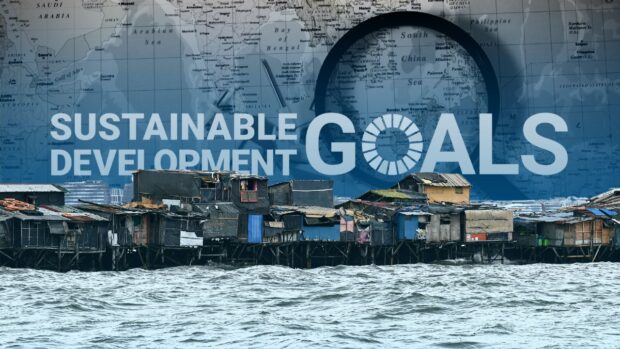PH SDG score: Good in curbing poverty, teenage smoking

Composite image from stock photos, Agence France-Presse, and the United Nations by JEROME CRISTOBAL / INQUIRER.net
MANILA, Philippines — The Philippines has performed well in curbing poverty and teenage tobacco use as part of its Sustainable Development Goals (SDG) targets. But it performed badly in reducing unemployment and increasing per capita income.
These are reflected in data that the Philippine Statistics Authority (PSA) presented on Monday to the Senate Committee on Sustainable Development Goals, Innovation, and Futures Thinking during a hearing on the country’s SDG performance.
Poverty cut in half by 2030
According to the PSA report, the Philippines is on track to cutting in half the proportion of the population living in poverty. The proportion was 18.1% in 2021, 16.7% in 2018, and 23.5% in 2015.
“It went up again in 2021 because we were still in the pandemic period,” assistant national statistician Wilma Guillen told the Senate panel. “And the target for this, according to the national SGD, is half of the 23.5 percent that we had in 2015. So we are looking forward to a 10.8 percent poverty by 2030.”
“So hopefully by this measure, it is saying that we are on track on this SDG targets,” she added.
Article continues after this advertisementFewer teens using tobacco
Tobacco use among individuals aged 15 and below went down to 19.5% in 2021 – a huge reduction from 29.7% in 2009 and 23.8% in 2015, Guillen said.
Article continues after this advertisementThe Philippines, she pointed out, was also on track to meeting this SDG target.
“By 2030, we should be achieving 15.3 percent prevalence of current tobacco use among persons aged 15 years old and below,” she said.
Both indicators — reducing poverty and teenage tobacco use — are included in 11 out of 155 indicators (16.9%) and seven out of 97 targets (16.7 %) that are achievable by 2030.
In contrast, there are 31 indicators (47.7%) and 18 targets (42.9%) that need more work if they are to be achievable by 2030.
Erratic indicators, targets
Meanwhile, 25 indicators (35.3%) and 17 targets (40.5%) showed either no progress or even regressed. This means these indicators and targets might not be achievable in 2030.
“The Target 8.1… is to sustain per capita economic growth in accordance with national circumstances and in particular at least seven percent gross domestic product (GDP) growth per annual in the least developed country… we can see an erratic trend here, from 2001 to 2004 it has been increasing, it decreased for 2005 and 2006, and again it went up in 2007, down again until 2009,” Guillen said.
“We saw an improvement in 2010. It went down in 2011, and from 2013, it has performed erratically […] But because of the pandemic in 2020, you can see here a very big drop, the annual growth rate of GDP per capita for the Philippines was at minus 10.8 percent, but we were able to recover in 2021, at 4.3 percent,” she added.
In 2021, the unemployment rate was at 8.2% — which means that the country is regressing from the unemployment rate targets.
The PSA also showed that the country regressed in Target 8.6, which seeks to limit the number of Filipinos aged 15 to 24 years old not in education, employment, or training. The SDG target for 2030 is to bring this down to 10.0% from the current 30.0%.
Cayetano alarmed
Sen. Pia Cayetano, the committee chair, welcomed the data on reducing poverty, saying in a mix of English and Filipino: “Of course, that’s good. That to me is a major indicator, this poverty level. We are on track in that one. In fact, that’s the highest performing.”
The other data, however, alarmed her.
“But here in our lowest performing [indicators], — so wow. Can you imagine if our youth is not being educated, not being trained? And even if you assume that their employment is not skilled-employment — and not employed, what kind of future is that?” she said.
“We may not be in poverty, but the quality of life that our youth will face — I mean, that’s what I want to dissect… I’m hoping that we can continue to work together to really dissect [this],” she added.
There have been assessments over the years that the Asia Pacific Region is not expected to meet the SDG set by the United Nations for 2030 — with as much as 90% of the goals unfinished.
The Philippines may be showing signs of progress, but it appears that there are some goals that it would not have a good chance of hitting by 2030.